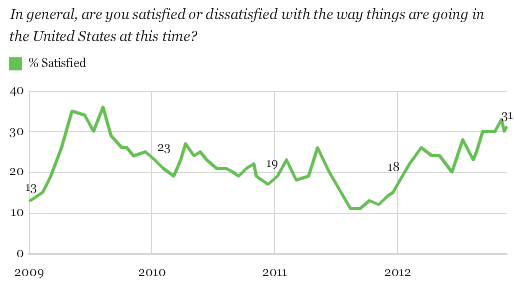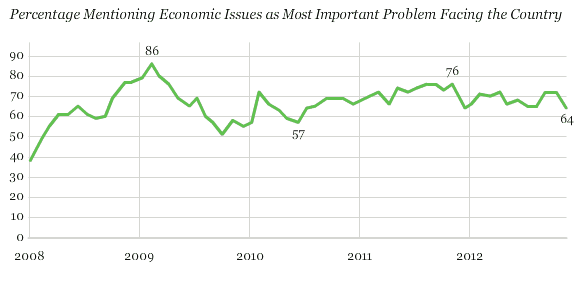PRINCETON, NJ -- Americans' satisfaction has stabilized, with 31% saying they are satisfied with the way things are going in the U.S. Satisfaction levels have been at or above 30% since September, after being below that mark for three years beginning in late August/early September 2009.

Americans have been decidedly pessimistic about national conditions for several years, predating the economic downturn. Since May 2007, the percentage satisfied with the direction of the country has reached 30% or better in only seven months -- for four months early in President Obama's first year in office (from May through early August 2009) and in each of the last three months, from September through November.
By contrast, the historical average satisfaction rating, based on Gallup measurements since 1979, is 38%. The all-time high is 71%, recorded in February 1999, and the all-time low is 7% from October 2008.
The rise in satisfaction in recent months has been due mainly to Democrats' increasing satisfaction, first apparent shortly after the Democratic National Convention nominated President Barack Obama to be the party's presidential candidate a second time.
Currently, Democrats are more optimistic than pessimistic about the state of the country, with 51% satisfied and 46% dissatisfied. In contrast, only 9% of Republicans are satisfied while 91% are dissatisfied. Independents are also more dissatisfied (69%) than satisfied (29%).
Economic Concerns Still Foremost in Americans' Minds
Despite the recent rise in satisfaction, as well as the similar rise in Gallup's Economic Confidence Index, Americans still predominantly mention economic matters when asked to name the most important problem facing the country. All told, 64% mention some economic issue; at least 60% have done so each month since July 2010.

Economic mentions peaked at 86% in February 2009 during the economic downturn that started in 2008.
In terms of specific issues, Americans rate the economy in general as the most important problem, followed by unemployment. Those issues are followed by dissatisfaction with government and the federal budget deficit. Healthcare is the only other specific issue mentioned by at least 5% of Americans this month.
The relative rank ordering of those issues has been fairly consistent over the past 12 months.
Implications
Though Americans remain much more dissatisfied than satisfied with the state of the nation, their satisfaction levels have been holding at a slightly higher level during the past three months. Certainly, government efforts to avoid the "fiscal cliff" could have a marked impact on satisfaction going forward.
Satisfaction ranged between 11% and 14% last August-November, spanning the time the government agreed to raise the federal debt limit and the time the federal budget deficit "supercommittee" failed to reach agreement on debt reduction measures, leading to the scheduling of the fiscal cliff spending cuts and tax increases for Jan. 1, 2013.
Thus, the challenges are clear for President Obama and Congress to keep the higher level of U.S. satisfaction going through the end of the year and into next year.
Survey Methods
Results for this Gallup poll are based on telephone interviews conducted Nov. 15-18, 2012, with a random sample of 1,015 adults, aged 18 and older, living in all 50 U.S. states and the District of Columbia.
For results based on the total sample of national adults, one can say with 95% confidence that the maximum margin of sampling error is ±4 percentage points.
Interviews are conducted with respondents on landline telephones and cellular phones, with interviews conducted in Spanish for respondents who are primarily Spanish-speaking. Each sample includes a minimum quota of 400 cellphone respondents and 600 landline respondents per 1,000 national adults, with additional minimum quotas among landline respondents by region. Landline telephone numbers are chosen at random among listed telephone numbers. Cellphone numbers are selected using random-digit-dial methods. Landline respondents are chosen at random within each household on the basis of which member had the most recent birthday.
Samples are weighted by gender, age, race, Hispanic ethnicity, education, region, adults in the household, population density, and phone status (cellphone only/landline only/both, cellphone mostly, and having an unlisted landline number). Demographic weighting targets are based on the March 2011 Current Population Survey figures for the aged 18 and older population living in U.S. All reported margins of sampling error include the computed design effects for weighting.
In addition to sampling error, question wording and practical difficulties in conducting surveys can introduce error or bias into the findings of public opinion polls.
View methodology, full question results, and trend data.
For more details on Gallup's polling methodology, visit www.gallup.com.